Ruins of MexicoCreated at Britta's and Adrio's home in San Cristobal de Las Casas, Mexico, in May 2004We were so much taken with the ruins of the prehistoric cities of Monte Alban and Palenque that we want to dedicate a special page to them. Unfortunately, there is only one photo of Monte Alban because, on the day we went there, the batteries of our digital camera went on strike :-( |
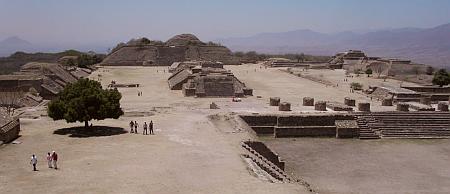 Monte Alban near Oaxaca is a centre of ritual and ceremony populated by settlers over a uniquely long period of over 1,000 years. People as early as the Olmeks built there already, and Zapotecs and Mixtecs left behind wonderful pieces craftwork in over 200 tomb temples. The whole structure is characterized by its impressive size and the length over which it is stretched. View from the southern platform over the great square. (mi) |
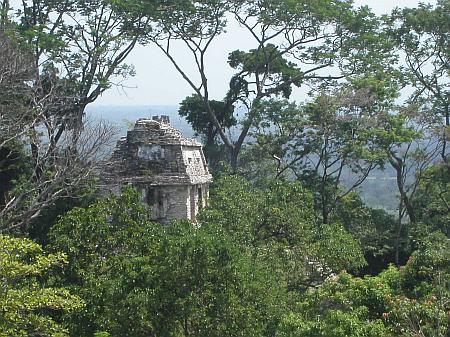 In contrast to Monte Alban, which is situated on a dry and bare hill top (water was carried up there at great effort, and rain collected in pools digged into the ground), the town of Palenque on the river Otulum was built into the exuberantly growing jungle. Thanks to conservation as a national park this unique jungle atmosphere can still be experienced today. Tempo del Conde (Temple of the Count) with view of the wide plains of Yucatan. (ma) |
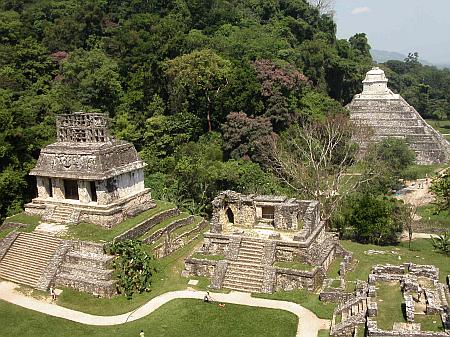 View over a group of temples in Palenque against the backdrop of mountains covered with lush jungle. From left to right:Templo del Sol (Temple of the Sun), Temples XIV and XV, and, in the background on the left, Templo de las Incripciones (Temple of Inscriptions). At Templo del Sol, the cresteria (the roof structure typical of Palenque ruins) has been almost fully preserved. (mi) |
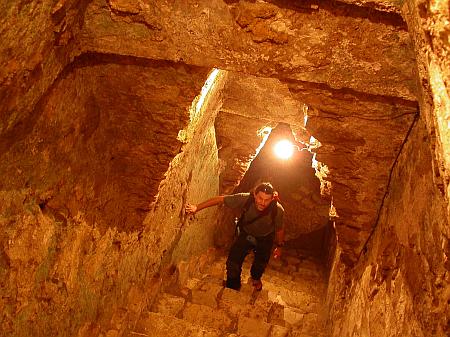 It was by lucky chance that we met Haydee Orea, the wife of archeologist Arnoldo Gonzales Cruz, who, in 1994, discovered the tomb of the "Red Queen" neighbouring to the Temple of the Inscriptions. We met Haydee in San Cristobal twice and had very interesting conversations about the pre-hispanic cultures of Mexico and about the archeologists' work. Besides we learned from her where to obtain permission to visit the tomb of Pacal Votan, the great Mayan ruler. Thus we were able to enjoy this unique experience of climbing down into a big tomb pyramid. Markus on the steep, slippery steps down to Pacal's tomb. (mi) |
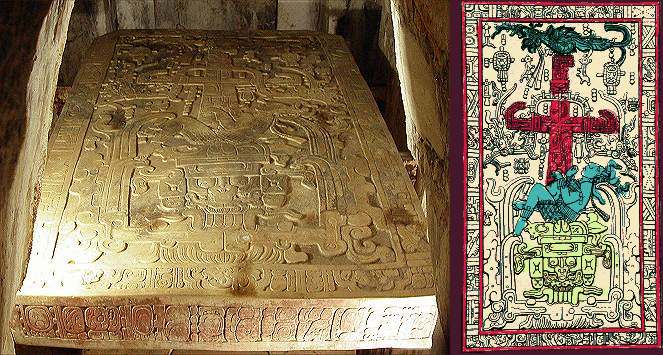 The gorgeous slab on Pacal's tomb is adorned all over with reliefs carved into it at great effort. Erich von Däniken (a Swiss author of popular science books who develops what are considered far-fetched theories about the remains of ancient cultures) must have had his imagination running wild when he saw the rich ornaments. Because whoever just has eyes in their head, along with a minimum of information about Mayan mythology, can clearly recognize the head of an underworld god, and on top of it Pacal gliding down to the Realm of the Dead, and above that the typical cross-shaped symbol of the world tree and the Celestial Bird. Due to the clarity of its depiction, due to information contained in Mayan scriptures, and due to the commonness of comparable representations, there is no way of re-interpreting the World Tree symbol, how much Erich von Däniken may ever like to see it as a UFO. For further information on the Mayan World Tree, see "art/Project World Trees/Mexico" (mi) |
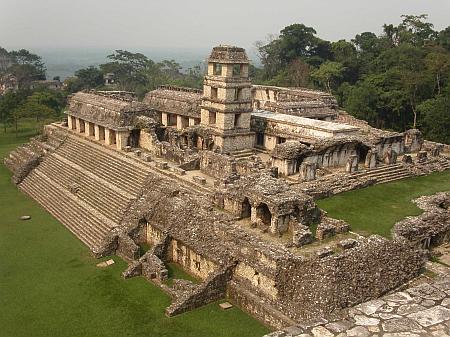 El Palacio (The Palace) was built to a plan as complex as a labyrinth. It is not that easy to find one's way in it. It was only on the second day that we managed to walk through the numerous corridors, galleries, rooms, and tunnels in the directions we actually wanted to go. View on the Palace, from the Temple of the Inscriptions (mi) |
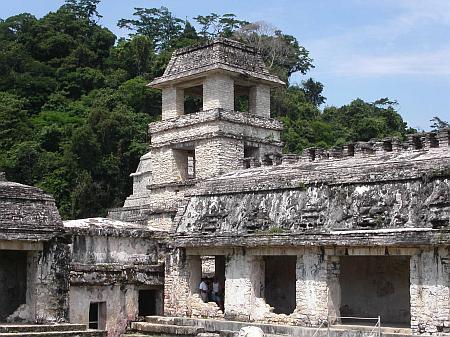 View on the tower of the Palace. It used to be seen as an observatory, but today it is considered to have been a watch tower. The surface of the roof shows ornaments, and on top of the roof, there are the remains of the "cresteria", a characteristic ornamental roof structure (see above, the cresteria of the Temple of the Sun). (mi) |
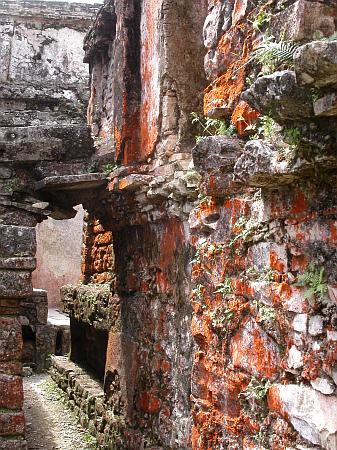 Everywhere in the Palace, exciting details can be discovered. Parts of the original ornamental painting (originally, the complete palace was covered in stucco and paint), traces of stone engravings and stucco work, old niches for storage purposes, as well as bath rooms and an intelligently designed sewage system. The red spots on this photo, however, are not paint but fungi and lichen, which grow richtly in the hot and humid climate. (ma) |
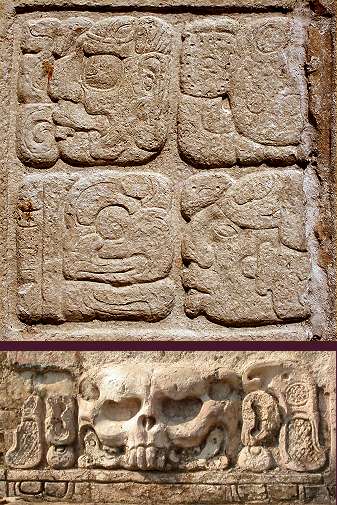 Details like these can still be discovered in the Palace and the Temples, even though much was lost through theft and impact of the environment: glyphs in one of the inner courtyards of the Palace (ma), below a skull relief in the Templo de las Calaveras (Temple of Skulls) (mi) |
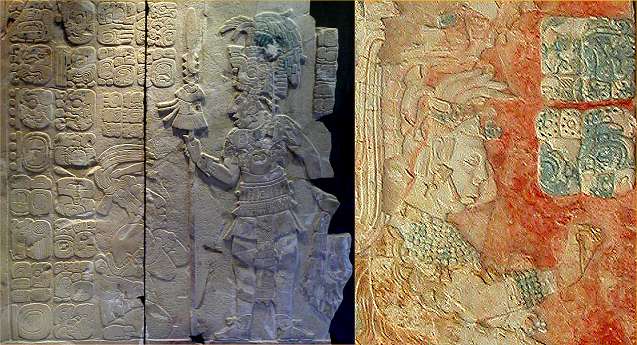 In the local museum, some particularly beautiful stone and stucco plates, as well as artfully made Mayan ceramics can be admired. Skillful craftmanship, an asthetically appealing glyph script, a symbolic language full of imagination, as well as a well-developed sense of proportion and beauty all cause the Mayan heritage to be a source of inspiration for many people up until today. Left: plate from Temple XVII, on which a ruler of Palenque is shown after a war of conquest. The glyphs describe historic events. (ma). Right: Multi-coloured stucco from Temple XIX showing another ruler of Palenque (ma) |
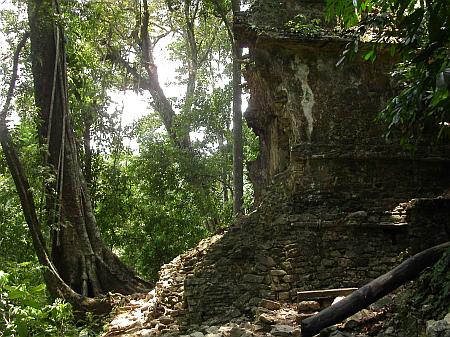 The main temples and the Palace were cleaned and secured at great effort to prevent accidents and vandalism. Yet this makes them look a bit sterile, unfortunately. A short distance away, however, further in the jungle, there are still enough other ruins where the wildly romantic atmospere has been preserved. Templo del Jaguar (Temple of Jaguar), close to which we took new tree pictures. See "art/Project World Trees/Mexico" (mi) |
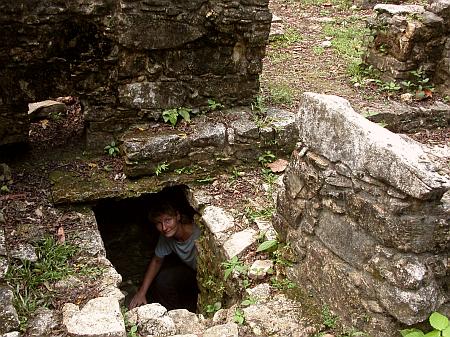 The Mayans were persons of very short stature. Therefore you sometimes have to crawl into a tunnel on all fours to keep their tracks. It was in the half-overgrown ruins in the jungle that we enjoyed ourselves most. (ma) |
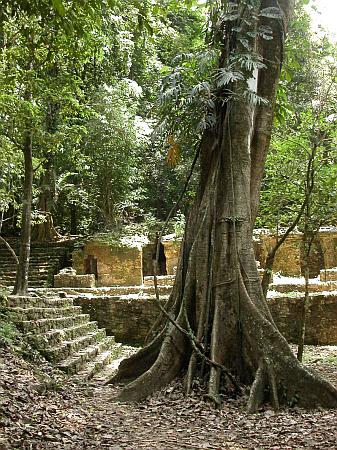 Palenque is such a large area that you can get footsore even on the second day of exploring it. But in fact only ten per cent of the original town has been excavated. More and more ruins were excavated and made accessible in the past years, like this group of residential buildings in the north of the museum site. Wherever you go in the jungle, old walls are waiting for their discovery. (mi) |
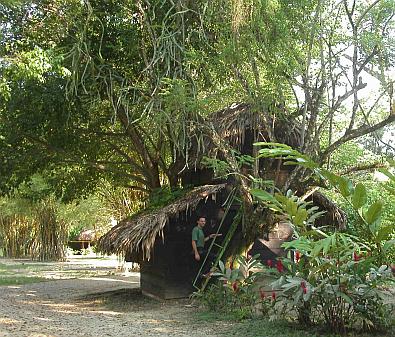 The Mayabell campsite close to the Palenque ruins was recommended to us several times. This time, by way of an exception, we did not have a tent with us, so the tree house was just right. Half way into the jungle, Mayabell has a great atmosphere. We have seen huge toads and moths, and heard the gurgling song of a toucan, as well as a howler monkey that sounds like a wolf with a sore throat. (mi) |
|
Epilogue: With Haydee we discussed extensively how the Mayans compare to the Romans, who lived at about the same time, and to the European peoples of the Middle Ages. Haydee pointed out that the Mayans are often grossly overestimated by laypeople. The Mayans were indeed clearly in advance of other cultures in some aspects (e.g. they had the most precise calender of their time, and they used the number zero in their calculations). In many other aspects, however, they were much less developed than other peoples. They did not have any metal tools and objects (except jewellery), and had not discovered the wheel yet. When their scriptures and other important remains of their culture were distroyed by the Spanish, invaluable information and historic heritage was lost. Scientists hope to gain new knowlede from further excavations, especially in the so far less thoroughly investigated north of Mexico. ___________________________________________________ |